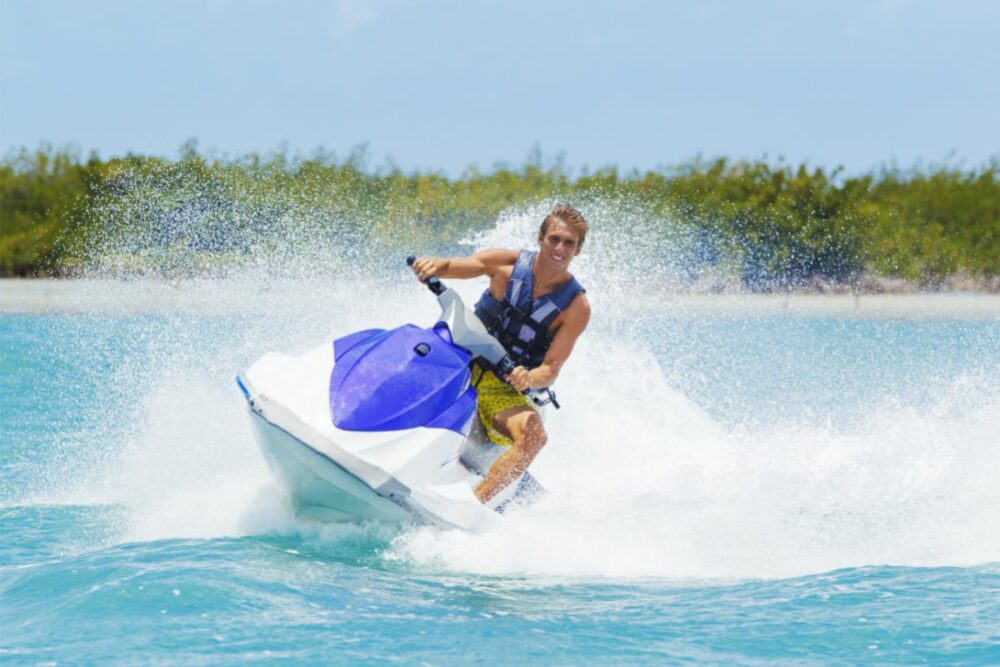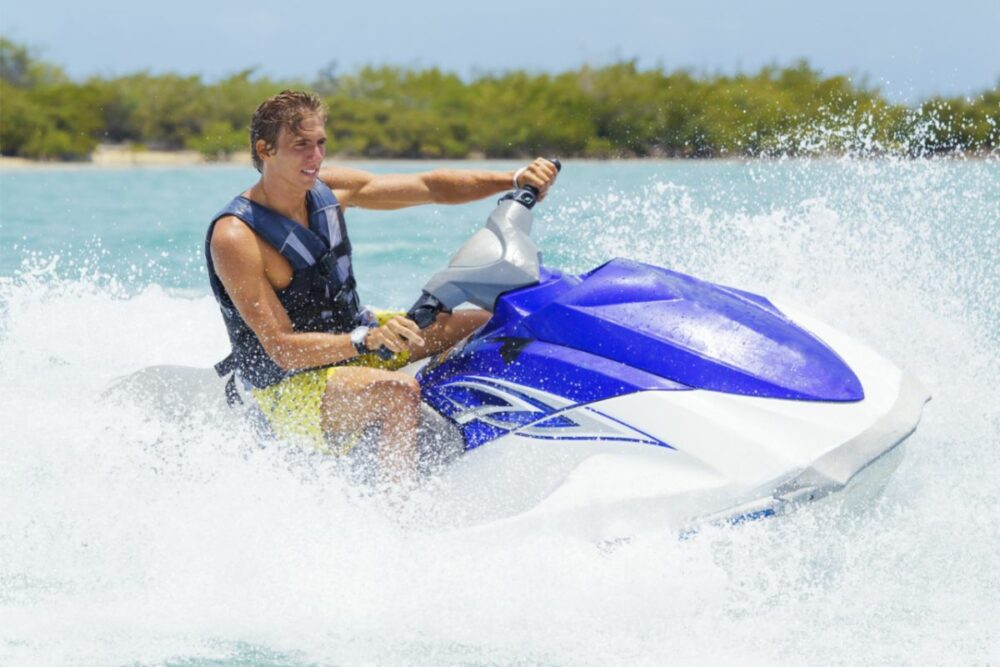PWCs, otherwise known as personal watercraft or even sometimes by the brand name Jet Ski, are very clever marine vehicles that utilize a pump and an impeller to channel and pressurize the water beneath you for propulsion. But without the rudder found on traditional watercraft, it’s not always clear how their steering system works.

They’re exceedingly nimble vehicles once you’ve mastered steering control, but they can be a little esoteric to beginners. The bike-style handlebars seem simple enough to wrap your head around, but even when moving these from side to side, you may find yourself drifting aimlessly in the water.
So to save you floating away, washing up on some deserted island, and making friends with your volleyball, let’s take a moment to study up on PWC steering control.
How Does The Steering Mechanism Of A PWC Work?
At the back of PWC, you’ll notice a small nozzle. This is where the pressurized water is released to provide propulsion. You can consider this the propeller and rudder of the vehicle. It’s responsible for both turning and moving you forward.
How, you ask? Well, if you have your PWC elevated and ask a friend to hop in and turn the handlebars while you observe the rear of the vehicle, you’ll notice the nozzle turns in unison.
This operational symmetry is facilitated by a series of cables that connect the handlebars (technically known as the steering control) to the nozzle.
So, in theory, to turn a PWC right, you’d turn the steering control to the right, and to turn a PWC left, you’d turn the steering control to the left, but before you carve up the big blue, there’s something else you should know.
Maintaining Steering Control In A PWC
On traditional watercraft, the motor provides power to the propeller via the transmission, thus turning the propeller to generate surge velocity.
The rudder sits behind the propeller, turning this way and that to redirect the motion of the forced water molecules, triggering a chain reaction that leads to sideways inertia, which is what turns the vessel.
A PWC, on the other hand, doesn’t have a propeller. As mentioned earlier, the nozzle is both propeller and rudder, which has some implications when it comes to steering.
The implications are that turning the nozzle using the steering control isn’t enough on its own to actually turn the vessel, as, in this instance, it’s only doing the job of a rudder, which is a useless component without the propulsion provided by the propeller.
This means that, in order to steer a PWC, the motor must be on, and the pump must be actively processing and pressurizing water. If no water is coming out of the nozzle, you will not have propulsion, and thus will not be able to turn the watercraft.
Can You Steer A PWC When The Motor Is Turned Off?
Being that the motor sits at the start of the sequence that generates propulsion, if it’s not turned on, you won’t be able to steer a PWC, as, again, the nozzle will only be acting as a rudder rather than both rudder and propeller.
So, while it might be nice to shut your motor down and enjoy a few serene moments bobbing freely around in the ocean, to regain control, you’ll need to fire the motor back up.
Can You Steer A PWC When The Motor Is Idle?
When your motor is idle, although it’s still facilitating minimum combustion in order to run, it’s not actively powering the pump, meaning there will be no propulsion and no steering control no matter how you turn the handlebars. The PWC motor must be in full swing before you can control its direction.
While this may feel a little awkward at first, especially if you’re not comfortable going hell for leather with the throttle just yet, it’s no different to the handling on a motorbike. Turning the handlebars of a bike is not enough to turn it, as you first need motion, which is provided by the motor.
The Importance Of Steering Control

The ability to steer a vehicle is obviously very important, but it may be even more crucial in a PWC than, say, your car, the reason being, your car has brakes and operates on solid, static ground, meaning even when not steering, you still largely have control.
By contrast, many PWCs don’t have brakes at all, and even when you turn the motor off, your momentum can drive you forward for a while, meaning some quick maneuvering may just well be your only way of avoiding disaster in certain circumstances.
Is It Hard To Steer A PWC?
PWCs are famously very easy to operate, and they can be tons of fun too! But if you’ve only ever driven with a steering wheel, the handlebar format may feel a little alien to you when you first step aboard, so it pays to take things nice and slow to begin with.
Travel no faster than 10 mph as you acclimate to the steering control, and only ever speed up when you’re feeling confident that you can do so without harming yourself or others.
If you’ve ever ridden a motorcycle, you’ll be more familiar with the steering control of a PWC, but even if you’re feeling right at home behind the steering control, it’s essential that you still take things easy while you get your bearings. Overconfidence is the number one cause of PWC accidents, of which there are many!
Final Thoughts
There you have it! — In order to maintain steering control of PWC, you need to have the engine actively running and powering the pump. Otherwise, even though the nozzle will be turning in sync with the handlebars, it won’t have the propulsion to deviate from the established course or stationary position.
That doesn’t mean you should always be traveling at full speed in order to steer. Keep the pump alive
- Wind-Assisted Propulsion Systems (WAPS): A Game Changer for Maritime Decarbonization – February 6, 2025
- 10 Boat Salvage Yards in California – January 25, 2025
- 13 Boat Salvage Yards in Texas – January 18, 2025




